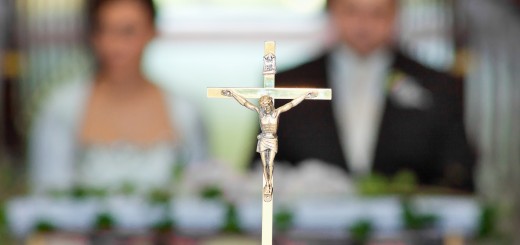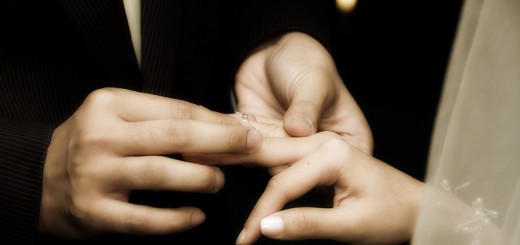Marriage & Same-Sex Attraction (2)
The Catholic Understanding of Marriage
1. What is the Catholic Understanding of Marriage
2. Do other Christian Churches share the Catholic understanding of Marriage?
3. Do other Religions share the Catholic understanding of marriage?
<< Next: The Meaning of Marriage & Sexual Difference >>
<< Key References | Abbreviations >>
1. WHAT IS THE CATHOLIC UNDERSTANDING OF MARRIAGE
The intimate community of life and love which constitutes the married state has been established by God. Marriage derives not just from social conventions but from the very nature of man and woman as they came from the hand of the Creator. God’s plan, from the beginning of creation, was that man and woman become “one flesh” as a sign of communion between two persons.[1] The sexual union of husband and wife seals and celebrates their marriage promises and their willingness to welcome new human life.
Marriage is also the natural basis of the family and thus of the care of children and the continuation of human society. Properly understood, marital love “demands indissolubility and faithfulness in definitive mutual giving”.[2]
Humankind, man and woman, are created in the image and likeness of the Trinitarian (three persons) God who is love. Since God created humankind man and woman, their mutual love becomes an image of the absolute and unfailing love with which God loves all humans. This love which God blesses is intended to be fruitful and to be realised in the common work of watching over creation: “and God blessed them, and God said to them: ‘Be fruitful and multiply, and fill the earth and subdue it.”[3]
Holy Scripture affirms that man and woman were created for one another: “It is not good that the man should be alone.”[4] The woman, “flesh of his flesh,” i.e., his counterpart, his equal, his nearest in all things, is given to him by God as a “helpmate”; she thus represents God from whom comes our help.[5] “Therefore a man leaves his father and his mother and cleaves to his wife, and they become one flesh.”[6] The Lord himself shows that this signifies an unbreakable union of their two lives by recalling what the plan of the Creator had been “in the beginning”: “So they are no longer two, but one flesh.”[7]
For the Catholic and Orthodox Churches, and for many in the Anglican Church, marriage is also a Sacrament – an effective, visible sign of God’s grace – which tells of God’s faithful and creative love and helps to make it real in that couple’s life together. This means that the unconditional giving of self between husband and wife is a visible sign of the unconditional giving of Christ’s self for his Church. Of its nature, this sacramental lifestyle, which has its origins in a God of love, brings the couple gifts or graces that they need to love each other generously, in good times and in bad, in sickness and in health, in imitation of Christ.
As a sacrament of the Church, “holy matrimony” consecrates human love, sexuality and procreation to a higher purpose. It unites the couple to God and makes them a sign of his covenant with his people. It
identifies the couple with Christ who has made their marriage a sign of his faithful and unbreakable love for his Church. It makes their family a “domestic church”.
Catholic theology, therefore, sees sexuality within marriage as having a threefold purpose or meaning:
- Sex is unitive – the total self-gift between a man and woman, based on their sexual difference, allow them to become the “one flesh” of a communion of persons.
- Sex is procreative – this bodily act of mutual self-giving and acceptance is ordered to a further good which transcends both spouses: the good of that new life which can be born from their union.
- Sex is parental – this new life calls the spouses to a further dimension and transcendence, an outward looking love, without which the sexual act risks turning in on itself, by concentrating on the search for pleasure alone.
In summary, the Catholic Church understands that marriage is more than a purely human institution that has been present in all recorded societies in history. It has a spiritual dimension which deals with love and therefore with the deepest yearnings of human experience. Although the dignity of this institution is not transparent everywhere with the same clarity, some sense of the greatness of the matrimonial union exists in all cultures. The well-being of the individual person and of both human and Christian society is closely bound up with the healthy state of conjugal and family life.[8]
[1] Gen 2:24.
[2] FC 13.
[3] Catechism of the Catholic Church (CCC), 1604.
[4] Gen 2:18.
[5] C.f., Gen 2:18-25.
[6] Gen 2:24.
[7] Mt 19:6.
[8] CCC, 1603.
2. DO OTHER CHRISTIAN CHURCHES SHARE THE CATHOLIC UNDERSTANDING OF MARRIAGE?
The vast majority of Christian Churches in Australia (and, indeed, around the world) broadly share the Catholic understanding that marriage relates only to the union of a man and a woman. This is despite the differences among the Christian denominations on the theological and sacramental understanding of marriage.
The commitment of Christian Churches in Australia to the understanding of marriage as being between a man and a woman was evident in the 2017 postal plebiscite. Groups including the Anglican Diocese of Sydney, Australian Baptist Ministries, C3 Christian City Church Australia, the Christian Reformed Churches of Australia, and the Greek Orthodox Archdiocese of Australia formally joined the Coalition for Marriage campaign to defend the traditional definition of marriage [9].
[9] https://www.coalitionformarriage.com.au/partners
3. DO OTHER RELIGIONS SHARE THE CATHOLIC UNDERSTANDING OF MARRIAGE?
The Organisation of Rabbis of Australasia, which represents the religious leadership of 90% of Australian Jewry, stated that Judaism recognises marriage as a fundamental human institution, and affirms marriage only between a man and woman.
Islam, the Bahá’í Faith and Sikhism also strongly affirm that marriage is the union of man and woman. Among Buddhists and Hindus, a plurality of views exists.
List of Abbreviations
CA – Pope John Paul II, Encyclical Centesimus Annus (1991)
CCC – Catechism of the Catholic Church, 2nd ed. (2000)
CDF 1986 – Congregation for the Doctrine of the Faith, Letter to the Bishops of the Catholic Church on the Pastoral Care of Homosexual persons (1986)
CDF 1992 – Congregation for the Doctrine of the Faith, Some Considerations Concerning the Response to Legislative Proposals on the Non-Discrimination of Homosexual Persons (1992)
CV – Pope Benedict XVI, Encyclical Caritas in Veritate (2009)
CSDC – Pontifical Council for Justice and Peace, Compendium of the Social Doctrine of the Church (2004)
DH – Second Vatican Council, Declaration Dignitatis Humanae (1965)
FC – Pope John Paul II, Apostolic Exhortation Familiaris Consortio (1982)
GS – Second Vatican Council, Pastoral Constitution Gaudium et Spes (1965)
LF – Pope John Paul II, Letter to Families (1994)
LL – USCCB, Pastoral Letter Marriage: Love and Life in the Divine Plan (2009)
PP – Pope Paul VI, Encyclical Populorum Progressio (1967)
RN – Pope Leo XIII, Encyclical Rerum Novarum (1891)
TOB – Pope John Paul II, Man and Woman He Created Them: A Theology of the Body, trans. Michael Waldstein (Boston: Pauline Books & Media, 2006). Other English versions are available online at EWTN’s website and at the Vatican website.
Key References
The official (Magisterial) teaching of the Catholic Church on Homosexuality and Marriage is found in the Catechism of the Catholic Church (1993) , and in three documents of the Vatican’s Congregation for the Doctrine of the Faith:
Catechism of the Catholic Church: The Sacrament of Matrimony
Download from link: CCC – The Sacrament of Matrimony
Catechism of the Catholic Church: The Sixth Commandment (Especially Paragraphs 2357-2359)
Download from link: CCC – The Sixth Commandment
Declaration on Certain Questions of Sexual Ethics: (CDF, 1975)
Download from link: Declaration on Sexual Ethics
Letter to the Bishops of the Catholic Church on the Pastoral Care of the Homosexual Person (CDF, 1986):
Download from link: Pastoral Care of Homosexual persons
Considerations Regarding Proposals to Give Legal Recognition to Unions between Homosexual Persons (CDF, 2003)
Download from link: Legal Recognition of Homosexual Unions
In May 2015, the Catholic Bishops of Australia issued a Pastoral Letter “to all Australians” on the ‘Same-sex Marriage’ Debate, entitled “Don’t mess with Marriage”. This summarises why the Catholic Church opposes moves to broaden the legal definition of marriage to include ‘same-sex’ relationships.
A Pastoral Letter from the Catholic Bishops of Australia to all Australians on the ‘Same-sex Marriage’ Debate
Download from link: ‘Same-sex’ Marriage Pastoral Letter
The following submissions by the Catholic Church in Australia to the Senate Legal and Constitutional Affairs Committee’s Inquiry into the Marriage Equality Amendment Bill 2010 also elaborate on Catholic Church teaching on marriage and same-sex attraction.
Submission 113: His Eminence Cardinal George Pell AC, Archbishop of Sydney
Download from link: (PDF 4791KB)
Submission 5: Opening Statement tabled by the Australian Catholic Bishops Conference at public hearing on Thursday 3 May 2012
Download from link: (PDF 1073KB)
Submission 234: Australian Catholic Bishops Conference
>Download from link: (PDF 113KB)
Catholic Teaching on Marriage is summarised in the following “Frequently Asked Questions” Booklet.
Marriage in the Catholic Church: Frequently Asked Questions Bishops Commission for Pastoral Life, 2006.
Download from link: Marriage in the Catholic Church
Other Non Catholic Church References
Regnerus, Mark: How different are the adult children of parents who have same-sex relationships? Findings from the New Family Structures Study. Social Science Research 41 (2012) 752–770.

